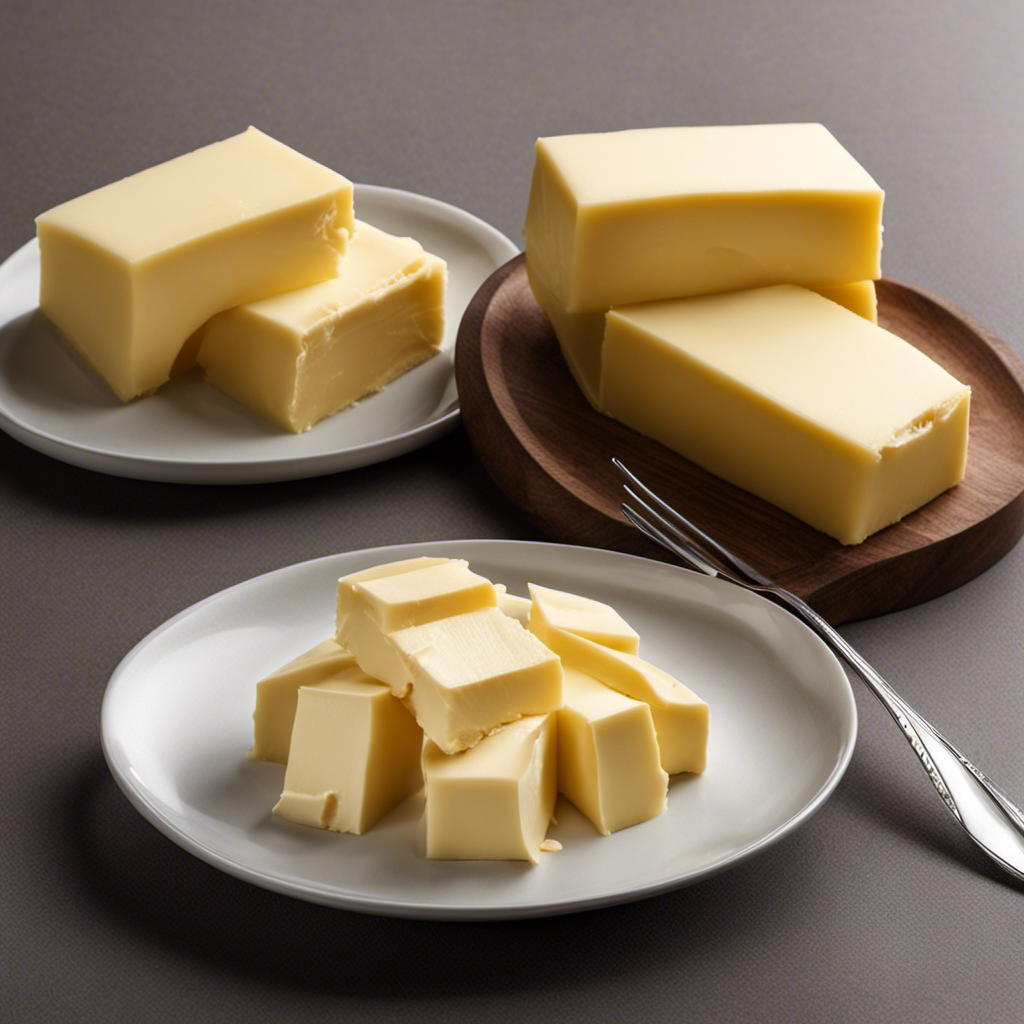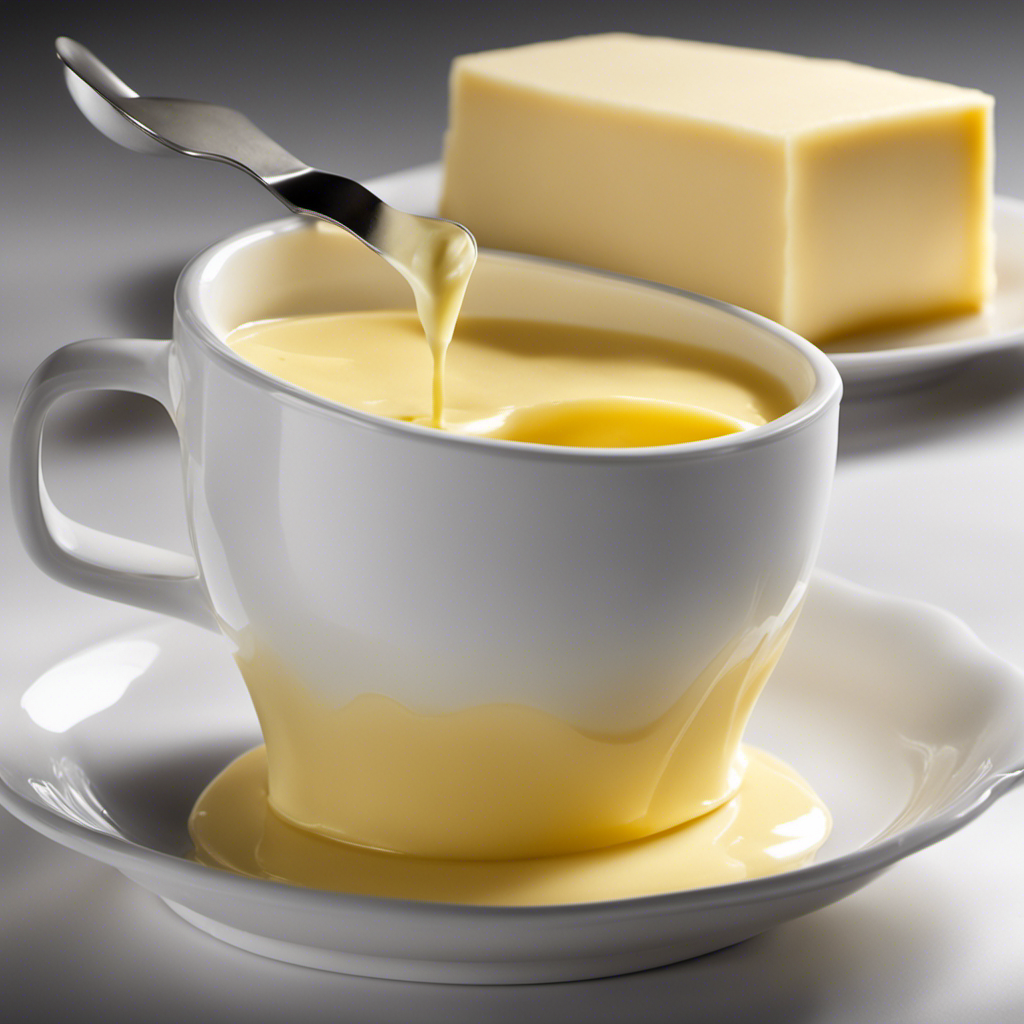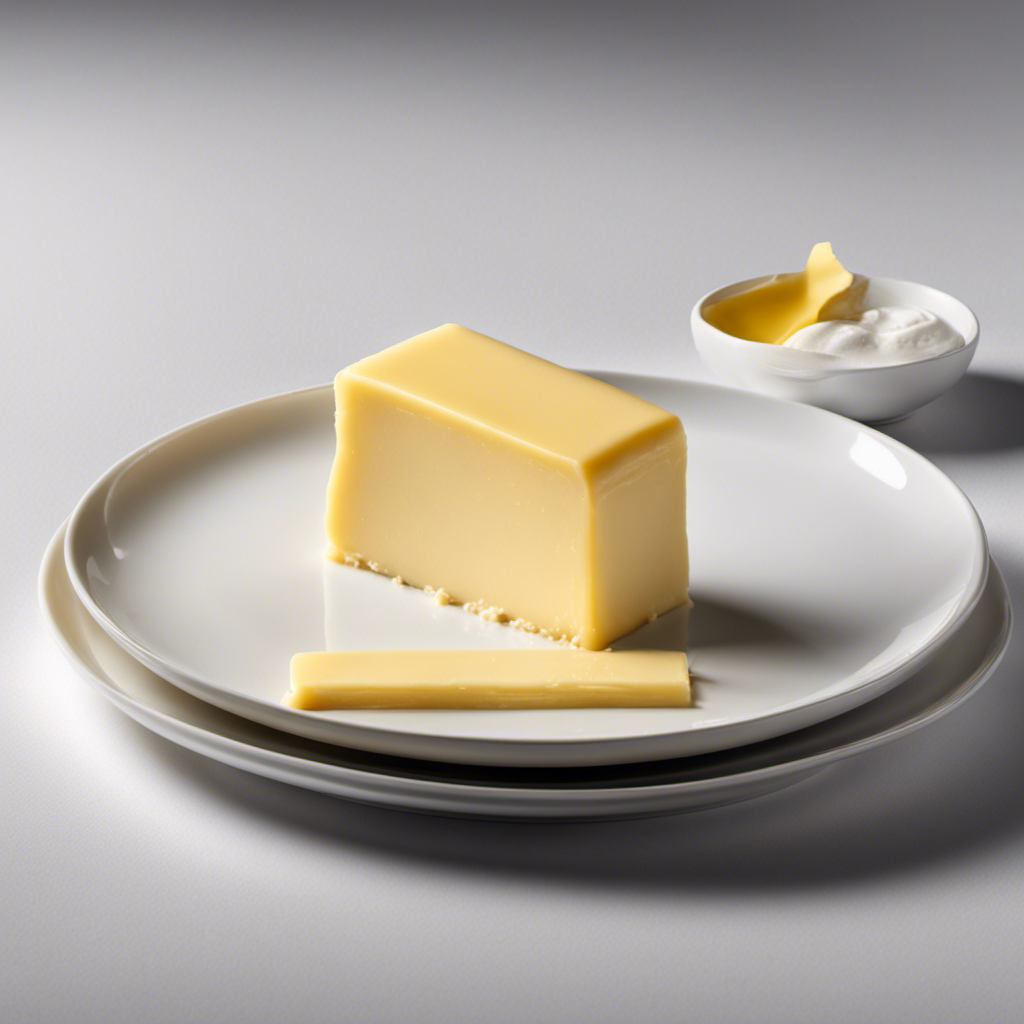My curiosity has always been piqued by the origins of my preferred butter, Kerry Gold. Therefore, after conducting some research, I uncovered an intriguing tale.
Picture this: a lush green landscape, dotted with rolling hills and picturesque farms. It’s here, in the breathtaking Irish countryside, that Kerry Gold butter is crafted with love and care.
In this article, we’ll take a closer look at the origins, production process, and global impact of Kerry Gold butter. Get ready to delve into the world of this delicious and iconic Irish treasure.
Key Takeaways
- Kerry Gold Butter is made in Ireland, where the rich green pastures and cool climate contribute to its quality.
- The butter is produced using traditional Irish farming practices that have been passed down through generations, ensuring a stress-free environment for the cows and high-quality milk.
- The butter is handcrafted with attention to detail by skilled artisans who oversee the process using traditional techniques.
- Kerry Gold Butter factories, strategically located near lush green pastures, are the heart and soul of the company and have been operating for generations with a deep-rooted commitment to preserving traditions and techniques.
The Origins of Kerry Gold Butter
Kerry Gold butter is made in Ireland, where the rich green pastures and cool climate contribute to the exceptional quality of this renowned butter.
The origins of Kerry Gold butter can be traced back to the traditional Irish farming practices that have been passed down through generations. Irish farmers take great pride in their work, ensuring that the cows are raised in a stress-free environment and graze on lush grass all year round. This results in milk that is naturally creamy and full of flavor.
The cows are predominantly a grass-fed breed, which further enhances the taste and nutritional value of the butter. The commitment to these farming practices is what sets Kerry Gold butter apart, making it a true taste of Ireland.
Historical Background of Kerry Gold Butter Production
During the early years, the production of this renowned dairy product began in Ireland. Kerry Gold Butter has a rich historical significance and is deeply rooted in Irish cultural traditions. Here are three key points about its history:
-
Traditional Churn: Kerry Gold Butter is made using the traditional churn method, where cream is agitated until it separates into butter and buttermilk. This method has been passed down through generations, preserving the authentic taste and texture.
-
Grass-fed Cows: The cows that produce the milk for Kerry Gold Butter are exclusively grass-fed. This not only ensures the highest quality milk but also imparts a distinct flavor profile to the butter.
-
Handcrafted Excellence: Each batch of Kerry Gold Butter is made with meticulous attention to detail, ensuring consistency and superior taste. Skilled artisans oversee the process, using traditional techniques to create a product that reflects the heritage and pride of Irish dairy farming.
With its rich history and cultural significance, Kerry Gold Butter factories can be found in various locations throughout Ireland.
Locating the Kerry Gold Butter Factories
Located in various regions throughout Ireland, the factories where Kerry Gold Butter is produced can be easily found. These Kerry Gold Butter factories are the heart and soul of the company, where the rich and creamy butter is carefully crafted to perfection.
Each factory is strategically located near lush green pastures, where cows graze on the finest grass, resulting in the distinct flavor and quality that Kerry Gold Butter is known for. These factories have been operating for generations, with a deep-rooted commitment to preserving the traditions and techniques that have been passed down through the years.
It is in these factories that the magic happens, where the cream is churned and transformed into the golden goodness that graces our tables. From the rolling hills of Ireland to your kitchen, let’s take a closer look at the journey of Kerry Gold Butter production: from farm to table.
Kerry Gold Butter Production: From Farm to Table
The journey of Kerry Gold Butter production starts on the lush green pastures of Ireland, where cows graze on the finest grass. It is here in the picturesque Irish countryside that the farm to table process begins, with a focus on sustainability practices and ethical sourcing.
The butter production process follows unique farming practices to ensure the highest quality product. Here is a glimpse into the Kerry Gold Butter production:
-
Sustainable farming: The cows are raised on sustainable farms, where they receive a diet of natural grass, promoting local dairy farming and reducing environmental impact.
-
Traditional churning: The cream is extracted from the milk and churned using traditional methods, preserving the rich flavor and creamy texture that Kerry Gold Butter is known for.
-
Global impact: By supporting Kerry Gold Butter, you are not only enjoying a delicious product, but also making a positive impact on the environment and local communities.
The Quality Standards of Kerry Gold Butter
One of the reasons people love Kerry Gold Butter is because of its high quality standards. Kerry Gold takes quality control seriously, ensuring that their butter meets the highest standards at every step of the production process.
From the selection of the finest grass-fed cows to the careful processing and packaging, Kerry Gold maintains strict quality control measures to deliver a superior product. The result is a butter that is rich, creamy, and full of flavor.
Not only does Kerry Gold Butter taste delicious, but it also offers nutritional value. It is made from the milk of grass-fed cows, which is naturally higher in beneficial nutrients like omega-3 fatty acids and vitamin K2.
Sustainability Practices in Kerry Gold Butter Production
When it comes to the production of Kerry Gold Butter, two key points that deserve attention are the environmental impact and the ethical sourcing of ingredients.
As a consumer, I am interested in knowing how the production process affects the environment, and what steps Kerry Gold takes to minimize their carbon footprint.
Additionally, I am curious to learn about their commitment to sourcing ingredients in an ethical and sustainable manner, ensuring that their butter is not only delicious but also produced with integrity.
Environmental Impact of Production
Did you know that the production of Kerrygold butter has a significant environmental impact? As someone who loves Kerrygold butter, I was surprised to learn about its carbon footprint and waste management practices.
Here are three key points about the environmental impact of Kerrygold butter production:
-
Carbon Footprint: The production of Kerrygold butter involves various stages, including farming, processing, and packaging. Each of these stages contributes to greenhouse gas emissions, primarily through the use of machinery, transportation, and energy consumption.
-
Waste Management: Dairy production generates significant amounts of waste, including animal waste and packaging materials. Kerrygold takes steps to minimize waste through recycling initiatives and promoting sustainable packaging solutions.
-
Sustainable Farming Practices: Kerrygold works closely with its farmers to encourage sustainable agricultural practices, such as responsible land management, water conservation, and biodiversity preservation.
Ethical Sourcing of Ingredients
To ensure ethical sourcing of ingredients, you should look for companies that prioritize fair trade practices and sustainable farming methods. These companies understand the importance of promoting local communities and supporting farmers who are committed to environmentally friendly practices.
Ethical sourcing means that the ingredients used in a product are obtained in a responsible and sustainable manner, without exploiting workers or harming the environment. By choosing companies that prioritize ethical sourcing, you can make a positive impact on both local communities and the planet.
These companies often work closely with farmers, ensuring fair pay and safe working conditions. They also promote local economies by sourcing ingredients from nearby farms, reducing the carbon footprint associated with transportation.
Supporting companies that prioritize ethical sourcing is a simple but powerful way to contribute to a more sustainable and equitable future.
Exploring the Irish Countryside: Home of Kerry Gold Butter
When it comes to butter production, there is something truly special about the process and the unique farming practices in Ireland.
From the rolling green hills to the traditional farming techniques, the Irish countryside plays a crucial role in creating the rich and flavorful Kerry Gold butter we all love.
In this discussion, we will delve into the intricacies of the butter production process and explore the fascinating farming practices that make Irish butter so distinct.
Butter Production Process
Have you ever wondered how Kerrygold butter is made? Well, let me take you through the butter manufacturing process and the butter production techniques used by Kerrygold.
Here’s a breakdown of the steps involved:
-
Cream Gathering: Kerrygold sources its cream from local Irish dairy farms known for their high-quality milk.
-
Churning: The cream is churned in traditional wooden churns, a technique that has been passed down through generations.
-
Salting and Packaging: After churning, the butter is carefully salted to enhance flavor and then packaged in the iconic gold foil wrapping.
Kerrygold’s commitment to using traditional methods and sourcing cream from Irish farms contributes to the unique flavor and quality of their butter.
Now that you know how Kerrygold butter is made, let’s delve into the unique Irish farming practices that make it all possible.
Unique Irish Farming Practices?
Irish farms contribute to the unique flavor and quality of Kerrygold butter through their commitment to traditional methods and sourcing cream locally.
Irish farming practices play a vital role in the production of this renowned butter. The lush green pastures of Ireland provide the ideal environment for cows to graze on nutrient-rich grass, resulting in the rich and creamy flavor of Kerrygold butter.
The cows are raised on small family farms, where they are given plenty of space to roam and graze freely. This traditional approach to farming ensures the highest quality milk, which is then churned into butter using time-honored techniques.
The butter production process involves carefully separating the cream from the milk and then churning it until it reaches the perfect consistency. The result is a butter that is rich, creamy, and full of flavor, a true testament to the unique Irish farming practices that go into its creation.
Promoting Local Dairy Farming With Kerry Gold Butter
Promoting local dairy farming with Kerry Gold butter helps support local farmers and their communities. As someone who values promoting local agriculture and supporting small-scale farmers, I am proud to choose Kerry Gold butter.
Here are three reasons why Kerry Gold is a great choice for promoting local dairy farming:
-
Sourced from Irish grass-fed cows: Kerry Gold butter is made from the milk of cows that graze on lush, green Irish pastures. By choosing Kerry Gold, you are directly supporting small-scale Irish dairy farmers and their sustainable farming practices.
-
Commitment to quality: Kerry Gold is known for its high-quality butter, made with traditional churning techniques. By purchasing Kerry Gold, you are supporting the craftsmanship of local dairy farmers who take pride in producing the finest butter.
-
Economic impact: When you buy Kerry Gold butter, you are helping to create jobs and stimulate the local economy. Supporting local dairy farming not only benefits farmers, but also their communities, ensuring a vibrant and sustainable future for all.
The Global Impact of Kerry Gold Butter Production
When you choose Kerry Gold butter, you are contributing to the global impact of sustainable dairy farming practices. The brand’s commitment to sustainable dairy farming practices ensures that the production process is environmentally friendly and supports the livelihood of farmers. By sourcing milk from grass-fed cows that graze on Ireland’s lush pastures, Kerry Gold butter not only delivers a delicious flavor but also promotes the well-being of the planet.
As the demand for high-quality butter continues to grow in the global market, Kerry Gold has become a trusted brand that meets these needs. The economic benefits of Kerry Gold butter production are significant, not just for the local Irish economy but also for the global market.
Frequently Asked Questions
Can Kerry Gold Butter Be Found in Stores Outside of Ireland?
Yes, Kerry Gold butter can be found in stores outside of Ireland. It has gained international demand due to its exceptional quality and rich flavor. People all over the world can enjoy the deliciousness of Kerry Gold butter.
What Is the Shelf Life of Kerry Gold Butter?
The shelf life of Kerry Gold butter is impressive. It can last up to six months when stored properly. The butter production process ensures its quality and freshness, making it a popular choice for butter lovers.
Are There Any Alternative Products to Kerry Gold Butter?
There are several alternative butter options available, each with their own unique health benefits. From grass-fed to plant-based, the choices are endless. Exploring different types of butter can add variety to your diet and enhance your culinary experience.
How Does Kerry Gold Ensure the Quality of Their Butter?
Ensuring the quality of Kerry Gold butter is a top priority. Through rigorous quality control measures and a meticulous production process, Kerry Gold maintains the highest standards to deliver a superior product to butter lovers everywhere.
Are the Cows Used for Kerry Gold Butter Production Treated Humanely?
Yes, Kerry Gold prioritizes cows’ welfare and ethical farming practices. They ensure their cows are treated humanely, which contributes to the high quality of their butter.
Conclusion
To conclude, Kerry Gold Butter is a true gem in the world of dairy products. Its rich and creamy texture, combined with the unique flavor, makes it a favorite among butter enthusiasts.
From the lush green pastures of Ireland to the tables around the globe, Kerry Gold Butter has become a symbol of quality and tradition.
So next time you spread a dollop of this golden goodness on your toast, remember the hardworking farmers and the picturesque landscapes that bring this delectable delight to your plate.
Embrace the taste of Ireland with Kerry Gold Butter, and let your senses be transported to the rolling hills and the gentle breeze of the Irish countryside.










